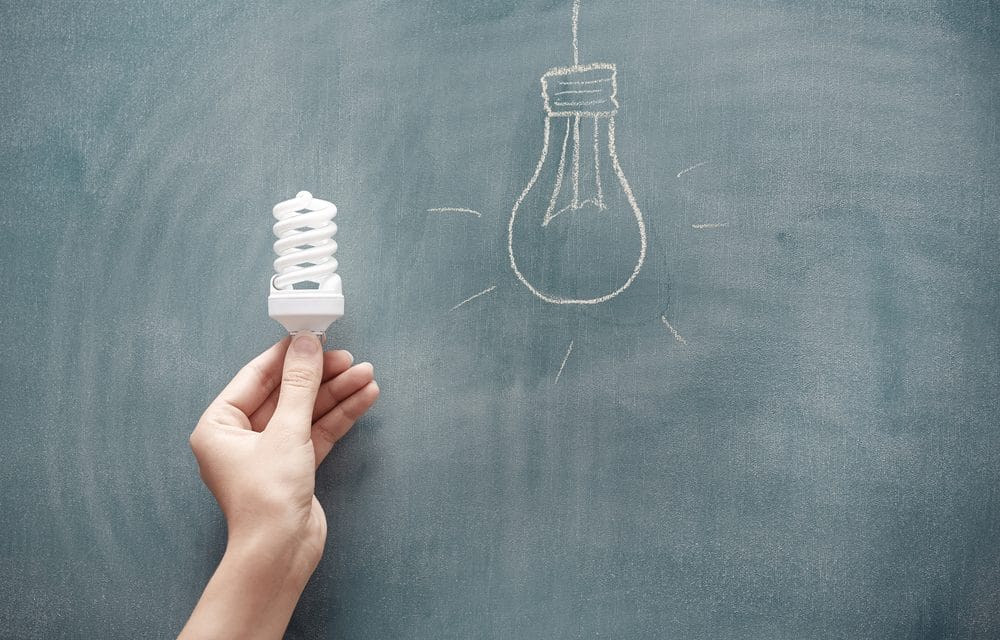According to the U.S. Energy Information Administration, about 40 percent of energy in the U.S. is used by homes and residential buildings. What’s more, the U.S. alone is responsible for 18 percent of the entire planet’s energy demands. Since we still rely primarily on fossil fuels for our energy and they release harmful greenhouse gas emissions, eco-conscious homeowners are turning to energy-efficient appliances and technologies to help reduce their home’s energy demands, as well as their carbon footprints. And saving energy can dramatically reduce your monthly utility costs, too. Plus, it can be incredibly simple! Read on for 18 easy energy-saving tips, almost all of which you could complete in just one day.
#1 Replace your incandescent bulbs with energy-efficient LEDs.
On average, 11 percent of a home’s energy budget is dedicated to lighting. Traditional incandescent bulbs are highly inefficient, converting only 10 percent of the energy they use into light and losing the rest to heat. By replacing the bulbs in your home with energy-efficient LEDs, you’ll reduce the energy needed to light your home by 50-75 percent. And the bulbs may be more expensive initially, but you’re sure to save money in the long run — LEDs last up to ten times longer than incandescents. Just imagine going over two decades without replacing a single bulb!
#2 Change your laundry habits.
Your laundry appliances account for about 13 percent of your home’s energy use. Making a few small changes to your laundry habits can significantly cut the amount of energy you use. Unless a load of laundry is particularly soiled, choose the cold water settings on your washing machine. Washing on hot places a huge demand on the water heater, another energy hog in your home. And even if you need to wash on hot, always use cold water for rinsing. Choose the lowest setting on your dryer at all times. Drying on “cool” won’t just save valuable energy, it will also help protect your clothes from damage.
#3 Use power strips to turn off idle appliances.
You’ve probably heard that unplugging all of your appliances and electronics while they’re not in use is a great way to save energy. Make it easy on yourself by adding power strips throughout your home, especially where there are many machines plugged in at one time. Simply switch off the power strip when you’re finished with those gadgets, and switch it back on when you need to use them again.
#4 Change or clean your furnace filter regularly.
When your HVAC system’s filter is clogged with dust and dirt, it has to work harder to keep heating and cooling your home. This extra work means extra energy use. Change the filter frequently to make sure that everything is running smoothly and efficiently — and to keep irritating particles out of your home’s air! Depending on the thickness of your filter, you’ll need to swap it out every 3, 6, or 12 months.
#5 Winterize your windows and doors.
Up to one-third of a home’s heat loss occurs through windows and doors. Make sure to seal your windows and doors with caulk, weather stripping, and/or plastic film, particularly if you live in a colder region. It can be done on the cheap, too — an investment of only $50 in weatherizing supplies can reduce your home’s heating costs by $100-$150. And don’t forget the basement windows!
#6 Shade sunny windows during the hottest parts of the day.
Particularly in the summer months, it’s important to keep south- and west-facing windows fully shaded during the hottest parts of the day. The sun’s powerful UV and infrared rays hit these windows the most, raising the temperature of your home and causing added stress on the air conditioning unit. Close the blinds and curtains when the sun is highest in the sky to help mitigate this effect. Take advantage of this effect in the winter to reduce how much your heater runs.
#7 Close blinds and curtains to keep the cold out.
You may be surprised to learn that simply closing your blinds and curtains can help keep the cold out and reduce your heating costs. But it’s true — shutting the blinds and curtains can help provide an extra barrier of insulation against the frigid outdoor air. In the winter months, keep these barriers up when the sun is down, and open them when the sun rises to take advantage of the sunlight’s warming effects.
#8 Install a programmable thermostat.
Just trust us — if you haven’t already made the switch to a programmable thermostat, do it now! A programmable thermostat will help conserve energy by changing the set temperature of your home depending on the time of day — for example, cooler than usual while you’re at work in the winter, and warmer than usual while you’re sleeping in the summer. The International Association of Home Inspection estimates that about 2 percent a home’s heating bill will be saved for each degree that the thermostat is lowered for at least eight hours each day. To put that in perspective, turning down your thermostat from 75 degrees to 70 degrees overnight in the summer will save you 10 percent in energy costs!
#9 Don’t over set the thermostat.
Setting your thermostat higher than you actually want it won’t heat your home any faster. Similarly, your air conditioner won’t run any harder if you set the temperature to cooler than you’d really like. All that will happen is your HVAC system will run longer than necessary, causing wasted energy. Patience is a virtue!
#10 Install a water-saving showerhead.
Get this: A family of four, each taking a five-minute shower a day, can save $250 a year in water heating costs by switching to a low-flow showerhead. And installation is incredibly easy: You’ll simply purchase the showerhead from a hardware store or online, unscrew your current showerhead, and screw the low-flow showerhead back on. Look for showerheads with the EPA’s WaterSense label to make sure you’re getting one of the most efficient models on the market.
#11 Insulate your water heater and hot water pipes.
Newer water heaters are made with improved insulation to reduce standby heat loss. But if your water heater is more than 15 years old, you should consider installing an insulating wrap to minimize wasted heat and energy as much as possible. It’s also a great idea to insulate hot water pipes wherever they’re accessible.
#12 Use smaller kitchen appliances.
Whenever possible, use your small kitchen appliances in lieu of your large oven. Microwaves, toaster ovens, and slow-cookers use as much as 75 percent less energy than ovens.
#13 Check your refrigerator door seal.
Run a quick test on the door seal of your refrigerator to make sure it’s an airtight seal: Close the door on a dollar bill. If you can easily pull the bill out, you should replace the gaskets to minimize cool air loss and energy waste. DIY replacement kits are available from an appliance dealer, home improvement store, or online.
#14 Wash full loads of dishes, and use the Air Dry cycle.
Your home’s dishwasher accounts for around 2 percent of your annual energy use. Only run your dishwasher when it’s completely full to get the biggest bang for your buck. And make sure to press the air-dry cycle button — this will eliminate the extra energy necessary for heat-drying your dishes, and they won’t be any less clean.
#15 Prepare for vacations.
Whether you’re leaving for a few days or a few weeks, take the time to prepare your home for your absence. Unplug every appliance and electronic that you can, and turn the thermostat off until you return (or to 55 degrees in the winter, to keep pipes from freezing!).
#16 Get a tankless water heater.
Tankless water heaters provide only as much hot water as is needed on demand, meaning none of the standby energy losses associated with storage water heaters. Tankless heaters heat water by running cold water through a pipe in the unit, where a gas burner or electric element heats the water as it passes through. As a result, you’ll still experience a constant supply of hot water, while saving a significant amount on energy costs.
#17 Upgrade your appliances.
If you’re wondering if upgrading your appliances would really make a difference, consider this: According to the EPA, if just 10% of homes used energy-efficient appliances, it would reduce carbon emissions by the equivalent of 1.7 million acres of trees. Look for appliances with the ENERGY STAR label; these products have been evaluated by the U.S. Department of Energy to be the most energy-efficient in their class.
#18 Do an energy audit.
When it comes to energy efficiency upgrades, there’s no substitute for a professional assessment! Investing in a professional energy audit of your home now will save you significant money in the future, and help you prioritize what should be done first to increase your home’s efficiency. An energy auditor will locate air leaks in your home using thermographic scanning to see where the most heat is being lost. And while an audit can cost upwards of a few hundred dollars, you’ll see energy savings from 5 to 30 percent simply from improving the airtightness of your home. If the cost of an audit is holding you back, visit Energy.gov for a free DIY energy use assessment.
Want to do more to reduce your use of energy from fossil fuels? Check out these articles:
- How to Buy Green Energy
- Easily Find Energy Efficiency Rebates, Tax Credits, Grants & Loans
- 10 Steps Toward a Zero Energy Home [Infographic]





![10 Steps Toward a Zero Energy Home [Infographic]](https://elemental.green/wp-content/uploads/2016/04/cbfb-440x264.jpg)


